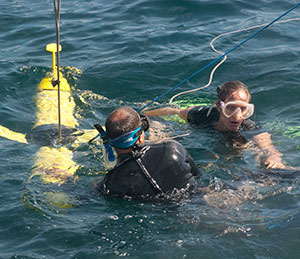Jul 20 2013
After tests about 40 miles offshore Galveston, Texas A&M oceanographers declared two new Slocum gliders ready to deploy in the Gulf of Mexico.
 Crew members from the R/V Manta position the glider for launching.
Crew members from the R/V Manta position the glider for launching.
A team of scientists and technicians from the Geochemical and Environmental Research Group (GERG), Department of Oceanography, and Texas A&M-Galveston used the NOAA research vessel Manta to test the gliders. The yellow, missile-shaped devices are autonomous underwater vehicles that operate by using an internal pumping system to change the buoyancy, allowing it to move horizontally and vertically.
The advantage to this kind of system, said Steve DiMarco, oceanographer and lead scientist, is the gliders' ability to be in the water for long periods of time and to travel over thousands of kilometers. "Its capabilities allow us to sample below the surface on a regional scale," he said, "something we have never been able to do."
Gliders typically carry a payload of sensors that measure parameters such as salinity, temperature, dissolved oxygen and currents. Glider pilots operate the gliders from land-based computers or mobile devices, sending instructions to the gliders on when, where and how to sample the water column. The gliders then surface at predetermined times to transmit data by satellites to the pilots. Pilots analyze the data and, if necessary, adjust the mission by sending a new set of instructions to the gliders.
"The gliders can even be programmed to ping your cell phone so don't have to be at the computer 24 hours a day," said Karen Dreger, a glider pilot employed by GERG.
"We will use the gliders to support research in physical and chemical oceanography, monitor for oil spills and other pollutants, and supplement stationary ocean observing systems already in place," said Tony Knap, director of GERG.
For now the plan is to gather information to better understand the Gulf. "The Gulf of Mexico is the ninth largest body of water in the world," he said. "Its effect on the lives and well-being of the 50 million people living in the Gulf states is undefinable."
Specifically, Texas A&M will work with researchers from Texas universities and institutes to install new sensors to monitor hypoxic conditions and harmful algal blooms, both tremendous threats to the health of the Texas Gulf Coast.
For the future, Knap says the goal is to have a fleet of 10 gliders that operate globally. "We will first learn to walk by deploying in the Gulf of Mexico, and then we'll go from there," he said. "We envision a consortium of academic, state and private entities to develop high-technology sensing of the remote ocean that is second to none."
See a video about the glider launch on the College of Geosciences YouTube site.